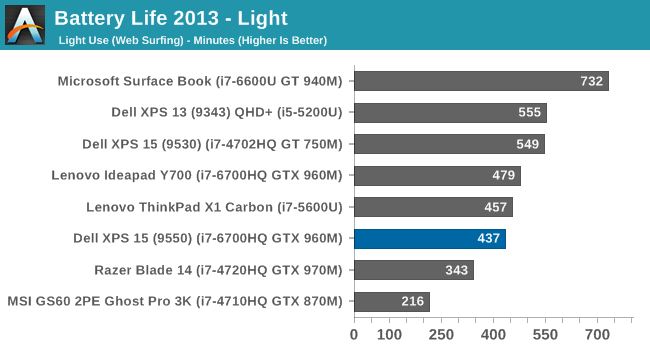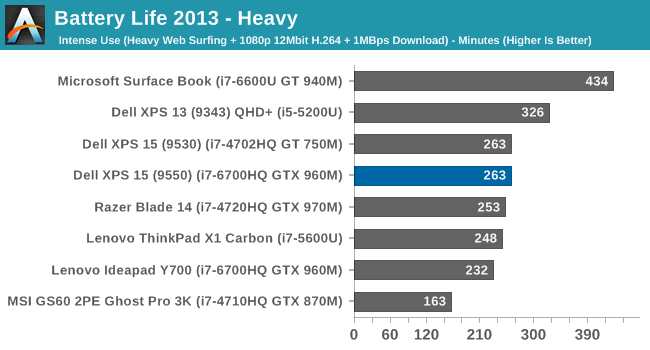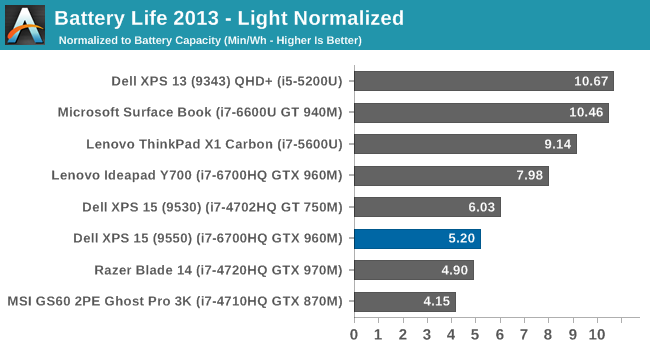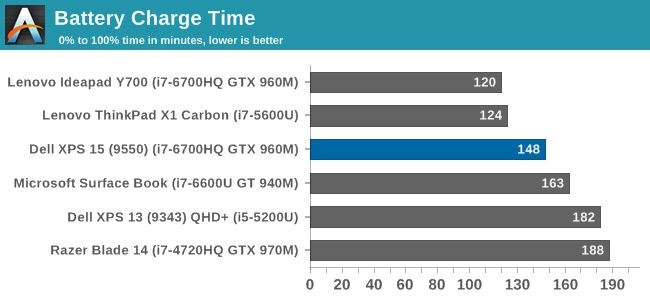The Dell XPS 15 9550 Review: Infinity Edge Lineup Expands
by Brett Howse on March 4, 2016 8:00 AM ESTBattery Life and Charge Time
The XPS 15 is available with two battery sizes. If you opt for the base model, it comes with a 2.5” SATA drive and a 56 Wh battery. If you opt for a device with the M.2 SSD, the extra space taken up by the 2.5” drive is replaced with more battery cells, giving you 84 Wh of capacity. It also adds about 0.5 lbs of weight to the device, but if you are going to be working away from an outlet, the SSD model should give much better battery life.
But, with the high resolution display, and wider color gamut, battery life is going to take a hit compared to something with a more traditional display. Since Dell sent us the UHD model, that’s the one we have to test.
To test battery life we have two tests. The light test involves light web browsing, with the display set to 200 nits brightness. The heavy test increases the pages loaded by the browser, adds a 1 MB/s file download, and includes movie playback. All testing is done with Edge as the browser.
Light Battery

The XPS 15, with its quad-core CPU and high resolution display, can’t keep up with the best devices for battery life, even on light usage. At just under 7.5 hours, it is well under the XPS 13 and Surface Book results, despite the larger battery. It is also below the XPS 15 9530 results, and that device has a 91 Wh battery and 3200x1800 display.
Heavy Battery

With the extra CPU workload, as well as constant network use, the battery life falls to just 4:23. This is exactly the same as the XPS 15 9530 score, so there is certainly some more efficiency because the display is higher resolution and the battery is slightly smaller on the new 9550 model. It’s still not a great result though.
Normalized Battery


By removing the battery size from the equation, we can get an overall feel for platform efficiency. The XPS 15, despite the higher resolution display, does outperform the XPS 15 9530 on the heavy results, but the UHD display certainly hurts it compared to other devices. The Surface Book with discrete GPU is over double the efficiency, but with a dual-core processor. The Lenovo Y700 has the same processor and GPU, but a much lower resolution display, and it comes out quite a bit ahead of the XPS 15. For those that are normally plugged in, the UHD display is fantastic, but be warned, it’s a big hit on battery life.
Charge Time
The other side of battery life is how long it takes to charge. With an 84 Wh battery, this is a significant amount of capacity to top up. Luckily Dell ships the XPS 15 with a 130-Watt power adapter.

At 148 minutes, the XPS 15 charges very quickly. At least with the less than stellar battery life, once you do plug it in, it gets back on its feet pretty quickly.











152 Comments
View All Comments
BillyONeal - Friday, March 4, 2016 - link
Erm, at least the one I have isn't matte.Daniel Egger - Friday, March 4, 2016 - link
Multi-touch? I believe all multi-touch screens are glare out of necessity, with Dell XPS the non-touch types should be non-glare.DanNeely - Friday, March 4, 2016 - link
There's no reason they need to be, the OEM could directly apply the same anti-glare coating you can get in a screen protector to the glass at the factory. They don't because a majority of people seem to prefer the smoother feel of glass to the slightly rougher surface of an matte surface. Hopefully as highdpi screens become more common market volumes will be large enough to support both types of screens at reasonable costs. Alternately, install a matte protector in the factory where cleanroom facilities can be made available to avoid dust headaches that make installing larger protectors a PITA.I'm indifferent to the feel and prefer the matte appearance. However I have a protector on my phone but not my tablet or laptop; although that's primarily driven by the difficulty of getting a dustfree install on larger screens. I know other people swear by it, but I'm 0/2 with large protectors in a shower fogged bathroom.
nerd1 - Friday, March 4, 2016 - link
Why are you looking after inferior OS with fewer applications?Daniel Egger - Saturday, March 5, 2016 - link
OS X is the most productive platform (of the many I use daily), plain and simple. Linux is nice and quick for command line interaction and running server applications but seriously lacks in the day to day job desktop area. Windows is great for gaming but sucks balls in pretty much any other department. "Inferior" is very much in the eye of the beholder; from a technical standpoint it certainly is not but clearly not everyone is capable being the judge of that.The *only* Windows application I *need* to use for work every now and then for which there is no good native Linux or Mac equivalent is XenCenter but for that I do have a sufficiently working Wine Bottle; for everything else I do have very capable applications, some of which are not even available for Windows...
nerd1 - Saturday, March 5, 2016 - link
I run all three OSes (windows, OSX and linux) on different machines and OSX has the worst file and windows management among three, even with EC (which seems to cause more harm than good)Daniel Egger - Sunday, March 6, 2016 - link
Nonsense, it has the best windows management (without tinkering) and either best or second best file organisation (with Linux) depending on what features you need and filesystem you're using on Linux; the legacy file organisation from Win 3.1 times is totally bogus and maybe you don't happen to have noticed but in non-English languages they're basically the only OS using translated names in the file system for some system directories making Windows essentially the only OS where you can't switch languages after the fact and causing lots of funnies when writing software. The only thing that truly sucks on OS X is fork performance (compared to Linux): A complex script run on OS X is usually executed a magnitude and some slower than on Linux, so if you compile a lot of cross-platform software (like me) you're loosing lots of wall time there...The things that bother me most about Windows are:
- It provides horrible privacy even after manually adjusting all of the 80 (partially hidden!) settings
- It is still quite unsecure, you'll have to install and maintain lots of tools to make sure you don't pick up any malware
- It comes with pretty much no usable tools, so just to get the bare minimum onto a fresh installation you'll have to spend a full weekend with chocolatey and/or portableapps just to make it usable
- Commandline is pretty much unusable, doing most of the work with a UI is a magnitude slower than on Unixish OSes
- Keeping all applications up-to-date is *the* *horror* and chocolatey unfortunately doesn't help much lately
- Weekly security updates, in Windows 10 even enforced, enforce a reboot completely disrupting the workflow. On OS X is usually have an uptime of many *months* before an update forces me to do a reboot and even then the state of my environment is preserved so I can basically ACK the reboot, pick up a coffee and continue where I left off. In Linux only Kernel updates require a reboot and those necessary for security usually only occur every other year or so.
Enough ranting for me on this topic. Just the view from a single IT and software development pro, YMMV.
ESC2000 - Sunday, March 6, 2016 - link
I can't speak to a lot of that but I can't believe you're claiming that OSX has a better file system or window management system. Even diehard OSX fans generally seem to admit that those are weaknesses of OSX. Can you even "snap" windows into place on OSX like you can on windows? My mom switched to OSX 3 years ago and still complains that she sometimes can't find files which is one of the reasons her next computer will be a PC. Malware or the lack thereof is admittedly a plus in the OSX column.sphigel - Friday, March 4, 2016 - link
These storage options are infuriating. You have to get the i7 model just to get an SSD?! That's ridiculous. SSDs benefit everyone regardless of how much processing power they need. They should be offered on every configuration.osxandwindows - Friday, March 4, 2016 - link
So true